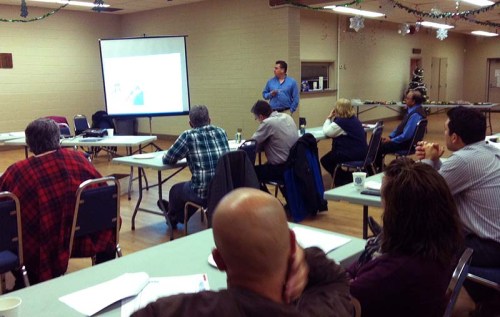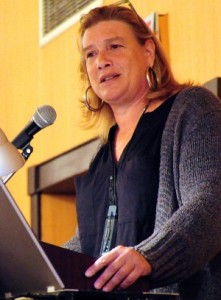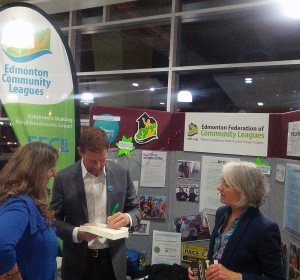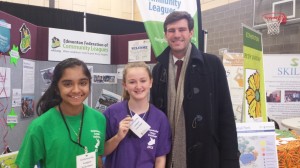By BARB MARTOWSKI, EFCL Communications Director
March 23, 2016 – Sometimes you just need a little help from your friends, or in this case, your fellow leagues.
On Saturday, March 12, roughly 30 volunteers from the EFCL and various community leagues descended on the community of Londonderry in Edmonton’s northeastern corner to do a door-to-door membership sales blitz in an effort to save the community league. Or to at least help jump-start it again.
The volunteers came from community leagues across the city, including McLeod, Steele Heights, Northmount, Oak Hills, Evansdale, Fulton Place, Aspen Gardens, Glenwood, Grandview Heights, Highlands, Parkallen, Woodvale, Ritchie, Downtown Edmonton and Strathcona Centre. The mission was simple – sell memberships and rally the community into attending a meeting to hopefully create a new board that could once again bring the neighbourhood together through a shared purpose of building a better community for all.

Volunteers showed up at Londonderry Hall early to grab a coffee and a identifying pinne before heading out the door.
At day’s end, roughly 89 memberships were sold in the blitz – more than enough to cover the 25 needed to hold a general meeting. Several others were purchased online and thanks to media coverage (both social and traditional), interest is continuing to build with Londonderry residents reaching out to the EFCL – all wanting to know how they can get involved.
Long before March 12
The story of Londonderry isn’t just about this one day – it came to the attention of the EFCL in early 2015, but the circumstances that brought Londonderry community league to its present position had been going on for some time. Londonderry Hall is the largest community league hall in the city, which means it also has the largest operating costs, and takes the most effort to run. The league simply found itself in a position of no longer being able to pay its bills, let alone run community programs. Both the city and the EFCL stepped in to help cover costs, and in May 2015, the EFCL took over the management of the hall.
Working together, both the city and the EFCL worked hard over the last 12 months to raise awareness in the community of the situation and that the neighbourhood stood to lose its hall. Open houses were held, information mailed out to all residents, but nothing seemed to work … until the door-to-door blitz which was to be the last ditch effort of the EFCL.
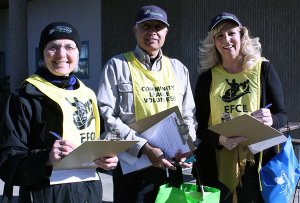
L-R Volunteers Bev Zubot (Parkallen CL), Habib Fatmi (Woodvale CL) and Joanne Booth (Strathcona Centre CL) are ready to go door-to-door in Londonderry Mar.12.
The previous lack of response had several of the organizers and volunteers worried about whether or not it would work, but when volunteers started coming back to the hall with their six or seven sales, optimism started growing. There was and is genuine hope for the revival of the Londonderry community league. Conversations at the door gave great insight into the importance of staying engaged – whether it’s the league with the community or the community with the league.
Many of the residents wondered about the hall, some were curious about what happened to their league. Others didn’t even know there was a league and some freely admitted they bought family memberships in neighbouring communities because there was nothing happening in Londonderry.
Many were seniors who had been in the neighbourhood for more than 40 years, and had been on the board while they were raising their families. It didn’t stop them from buying a membership in support but they did hope that younger folks would take over and not let it die.
And that’s what was important to the volunteers – that people not only purchased a membership, but were willing to get involved, to volunteer and sit on the board.
Leagues run on community-minded volunteers
So how did Londonderry get to this stage and what’s to prevent other long-standing community leagues from following its path?
The answer can probably be traced to one major thing – leaving too much in the hands of too few.

Dr. Rob Agostinis from Oak Hills CL in southwest Edmonton was just one of the many volunteers to go door-to-door during the Londonderry Membership Blitz on March 12.
Community leagues are about building strong, inclusive communities through programming and events, infrastructure development and civic engagement. They strive to provide the space and opportunity for neighbours to get to know each other, have fun and ultimately – support each other which strengthens the entire community. And who are they? They are community-minded volunteers and they’ve been doing this since 1917.
Like many non-profit boards and without intention, it can come down to the same few doing everything. They get tired out, but struggle to keep things afloat and that’s where things deteriorate and it becomes a vicious circle: no volunteers – no programs – no programs – no participation – no participation – no volunteers.
It’s not like this hasn’t happened to a league before. In 1980, Jasper Park sent out a special newsletter with the heading, “Jasper Park Community League, Died 1980” and went on to outline the consequences to the community if it closed its doors. In 1946, 100 kids rallied and marched through the Ritchie community carrying placards and demanding that the adults get back into the business of building a strong community by volunteering on the board. These are just a few of the more colourful ways leagues have been saved, but the reason was/is still the same – volunteer burnout.
Annual general meetings are right around the corner
Today there are 157 community leagues in Edmonton, and April, May and June are the prime general meeting months – the months when some board members will be stepping down and hopefully new members will take their place.
Every one of these leagues will be putting the call out to their members and the community at large, asking for people to get involved with the league. They’re looking for board members and also general volunteers – volunteers who might like to lead a program, join a committee or help out at an event.
… maybe my neighbourhood needs something from me.”
And they are hoping for a full house of community league members on AGM night, so they can share with their members, news on the work they have been doing for the past year on behalf of the community.
Don’t let your community league reach the point that Londonderry found itself in.
If you have enjoyed even one the benefits that your community league has created, whether it’s attending the community BBQ or pub night, or your child is playing a community sport, take a page from Londonderry resident, Zekaryas Woldemariam who bought a membership on the 12th, and who so eloquently said it in his interview with the Edmonton Sun, “I want to participate with my neighbourhood … maybe my neighbourhood needs something from me.”
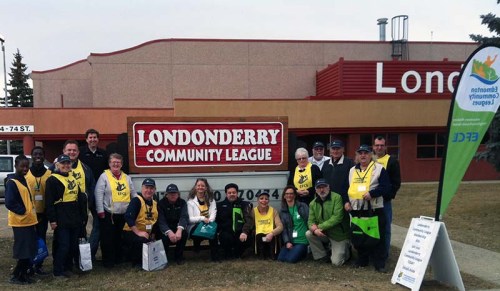
A few of the volunteers who came out in support of Londonderry Community League. All of these volunteers came from other leagues across the city and they believe in the value of strong community leagues and what they can accomplish for their communities.
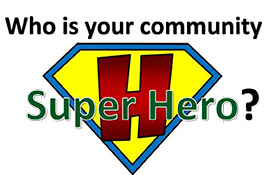 Nora Begoray, EFCL Marketing Director
Nora Begoray, EFCL Marketing Director





